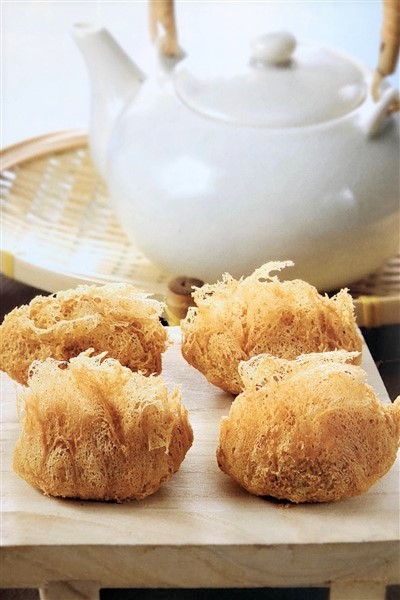Wu Gok - Deep-Fried Taro Dumpling Puffs
Dim Sum Taro Puffs: Crunchy Bites of Joy
Crispy taro puffs, or "wu gok" as they're known in Cantonese, are also sometimes referred to as "phoenix tail crispy dumplings". At traditional dim sum restaurants, the chef may sometimes cover the wu gok in phoenix tail shrimp, which is where this name comes from. Remember that it cannot be too crispy, so as to ensure its phoenix lifelike quality.
Chef's Corner
If the taro is not sticky enough, then it will be difficult to achieve proper crispiness. If taro is not available or its quality is not ideal, you can substitute mung bean, wild soybean, or salted egg yolk. When frying the wu gok, it is important to control the temperature of the oil. If it is too high, the wu gok will seal up, and it will not achieve the hollow effect it should have. If the oil temperature is too low, the wu gok will lose their physical integrity and easily fall apart.

Ingredients
- 1.32 pounds (600 grams) peeled taro
- 2/3 cup (150 grams) boiling water
- 2 teaspoons five-spice powder
- 2 teaspoons (8 grams) chicken bouillon
- 1 ¼ cups (150 grams) wheat flour
- 5.29 ounces (150 grams) lard
- 1 teaspoon (4 grams) salt
- 2 salted hardboiled egg yolk
Filling
- 5.29 ounces (150 grams) white mushroom, blanched and diced
- 1.32 pounds (600 grams) diced chicken, blanched
- 10.58 ounces (300 grams) diced shrimp, blanched
- 5.29 ounces (150 grams) diced dried shiitake mushrooms, blanched
- 4 teaspoons (19 grams) crushed garlic
- 4 teaspoons (19 grams) dried crushed onion
- 6 eggs, beaten
Seasonings
- 2 teaspoons (8 grams) salt
- 3 teaspoons (15 grams) chicken bouillon
- 2 tablespoons (23 grams) sugar
- 1 tablespoon light soy sauce
- 2 tablespoons oyster sauce
- 2 ½ cups (600 grams) stock
- 1 teaspoon ground pepper
- 1 ⅔ tablespoons (23 grams) sesame oil
- 6 tablespoons (57 grams) potato starch, added at the end
- 1/3 cup (75 grams) water, used for mixing the potato starch
Cooking Directions
How to make Wu Gok filling
- Heat oil in pot. Fry crushed garlic and dried crushed onion until fragrant. Add all filling ingredients (aside from the eggs), and fry until fragrant. Sprinkle a dash of cooking wine. Add seasoning ingredients and bring to a boil. Add potato starch and water until it achieves a thick consistency. Fry egg yolk. Scoop out and let cool.
How to make Wu Gok skin
- Use boiling water to knead wheat flour into dough. Chop peeled taro into slices. Place into steamer basket and steam over high heat 20 minutes. Crush. Add salt, chicken bouillon, five-spice powder
, and the wheat flour dough. Stir evenly. Then add salted hardboiled egg yolks and lard. Stir thoroughly. Refrigerate for 30 minutes. This is the taro skin.
Put it all together
- Separate taro skin into small circular wraps approximately 0.81 ounce (23 grams) each. Add about 0.81 ounce (23 grams) of filling to these and form into a dumpling shape, thus making the wu gok ready to be cooked.
- Heat oil to 392 °F (200 °C). Add wu gok. Fry until golden brown and crispy. Remove from pot and strain away excess oil.
Dumpling Arrangement
There are rules to how dumplings are arranged when making them as well. They cannot be placed haphazardly. There is even a saying that "You can be as busy as you like, so long as your dumplings are arranged neatly". When making dumplings for any ordinary occasion, one can arrange them however one pleases – horizontally or vertically are both fine. But this is not the case when making dumplings for Chinese New Year's Eve. In Shandong and nearby regions, the dumplings are formed into gold ingot shapes and placed in the center of a circular cloth. As more are placed down, they extend out in a ring-like pattern on the circular mat. This is known as yuan fu, or "circular fortune".